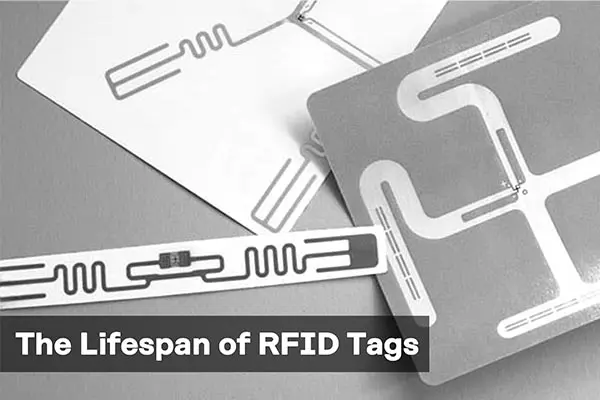RFID (Radio Frequency Identification) tags have become ubiquitous in modern society, revolutionizing various industries with their ability to track and manage assets efficiently. These small electronic devices consist of a microchip and an antenna, enabling them to transmit and receive data wirelessly via radio waves. In this article, we delve into the lifespan of RFID tags, exploring the factors influencing their longevity and strategies for prolonging their effectiveness.

Introduction to RFID Tags
What are RFID Tags?
RFID tags are small electronic devices equipped with a microchip and an antenna. They store and transmit data wirelessly through radio frequency signals.
Importance of RFID Tags in Various Industries
RFID tags play a crucial role in industries such as retail, healthcare, logistics, and manufacturing by enabling efficient asset tracking, inventory management, and supply chain optimization.
Components of RFID Tags
An RFID tag typically consists of a microchip, which stores the data, and an antenna for communication with RFID readers.
How RFID Tags Work
When an RFID reader sends out radio waves, the RFID tag’s antenna receives the signal, powering the microchip and enabling it to transmit data back to the reader.
Passive RFID tags do not have an internal power source. Instead, they draw power from the radio waves emitted by the reader device. When the reader’s radio waves energize the tag’s antenna, it powers up the microchip, allowing it to transmit the tag’s unique identifier back to the reader.

Factors Influencing RFID Tag Lifespan
Environmental Conditions
The lifespan of RFID tags can be affected by environmental factors such as temperature extremes, moisture, and exposure to chemicals or UV radiation.
Frequency of Use
RFID tags that are subjected to frequent read and write operations may experience faster degradation compared to those with lighter usage.
Material Quality
The quality of materials used in RFID tags, including the microchip, antenna, and packaging, can significantly impact their durability and longevity.

Average Lifespan of RFID Tags
Estimates and Studies
While there is variability among RFID tags based on their design and usage, studies suggest that the average lifespan of passive RFID tags ranges from 5 to 15 years.
That is a general data, among RFID product, RFID lifetime will depend on its application.
For example, RFID label is mostly applied in one time use project, even sometime it will be customized with fragile paper or material, but it is cheap and widely used in shoes & clothing industries RFID wristband could be customized with different material like paper, silicone and PVC, its lifetime is not only related to chip, also related to the material you choose.
RFID card is applied in everywhere, it could be used for a long time as long as it is well-preserved So the lifespan of passive tag will be related to different thing, material, application, environment are all metters.
In real-world applications, the lifespan of RFID tags can vary depending on factors such as the industry, application, and environmental conditions.

Prolonging the Lifespan of RFID Tags
Proper Maintenance
Regular inspection, cleaning, and maintenance of RFID tags can help extend their lifespan and ensure optimal performance.
Extending the lifespan of RFID tags requires proper maintenance and consideration of various factors that can affect their durability. Here are some effective ways to prolong the lifespan of RFID tags:
Regular Inspection: Conduct routine inspections to check for any physical damage or signs of wear and tear on the RFID tags. This allows you to identify issues early on and take preventive measures to mitigate further damage.
Proper Handling: Handle RFID tags with care during installation, operation, and maintenance. Avoid subjecting them to excessive force or bending, which can damage the components and reduce their lifespan.
Cleaning: Keep RFID tags clean by removing dirt, dust, and other debris that may accumulate on the surface. Use a soft, dry cloth or a mild cleaning solution to gently wipe away any contaminants. Avoid harsh chemicals or abrasive materials that could damage the RFID tags.
Protection from Environmental Factors: Shield RFID tags from extreme temperatures, moisture, humidity, and exposure to UV radiation. Store them in appropriate enclosures or protective cases to minimize the risk of environmental damage.
Avoiding Chemical Exposure: Prevent RFID tags from coming into contact with chemicals or solvents that can degrade the materials and components. Store them away from areas where corrosive substances are present to maintain their integrity.
Optimize Read and Write Operations: Minimize the frequency of read and write operations on RFID tags to reduce wear on the microchip and antenna. Implement efficient data management practices to limit unnecessary data transfers and prolong the lifespan of the tags.
Upgrade to High-Quality Tags: Invest in high-quality RFID tags made from durable materials that are designed to withstand harsh environments and heavy usage. While initial costs may be higher, the longevity and reliability of these tags can justify the investment in the long run.
Follow Manufacturer Guidelines: Adhere to the manufacturer’s recommendations and guidelines for the installation, operation, and maintenance of RFID tags. These guidelines are tailored to optimize the performance and longevity of the tags and should be followed accordingly.

Challenges in Determining Lifespan
Lack of Standardization
The absence of standardized testing methods and metrics makes it challenging to accurately assess and compare the lifespan of RFID tags across different manufacturers and applications.
Variability in Usage
The lifespan of RFID tags can vary widely depending on factors such as usage intensity, environmental conditions, and operational requirements.

Conclusion
The lifespan of RFID tags is influenced by various factors, including environmental conditions, usage frequency, and material quality. While estimates suggest an average lifespan of 5 to 15 years for passive RFID tags, real-world applications may experience variability. Proper maintenance and advancements in technology are key to prolonging the lifespan of RFID tags and ensuring their continued effectiveness in asset tracking and management.
.png)
